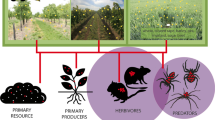Abstract
The management of field margin strips for the enhancement of biodiversity of plant-insect communities and natural-enemy populations was studied on experimental farms near Göttingen (Germany). Young and old, sown and naturally developed field margin strips were compared and differences to large fallows established. The five types of field margin strips (around cereal fields) were: (1, 2) 1- or 6-year-old naturally developed strips, (3) strips sown with a Phacelia mixture, (4) strips sown with a mixture of 19 wild flower species, and (5) strips sown with winter wheat or oat as a control. The naturally developed vegetation of the field margin strips was dominated by aggressive weeds, presumably due to the intensive farming practices and the fertile soils. Cirsium arvense populations decreased, while Elymus repens populations increased with age of habitat. Sowings were suitable to suppress these aggressive weeds. Potted plants of mugwort (Artemisia vulgaris) and red clover (Trifolium pratense) were exposed in the field margin strips to study arthropod colonization of these experimentally standardized plant patches. Arthropod species richness did not differ between field margin types, reflecting the overall similarity in floristic diversity, but sprayed and strip-free edges of cereal fields had a reduced diversity. Dispersal of insect populations of red clover into the cereal fields decreased with increasing distance, but benefited from adjacent field margin strips. Populations of predators (mainly spiders) as well as predator-prey ratios were significantly larger in 6-year-old than in 1-year-old strips emphasizing the importance of habitat age for natural enemies and possible biological control. Predator-prey ratios were also higher on old than young fallows. Large fallows had greater predator-prey ratios than small field margin strips emphasizing the trophic-level hypothesis of island biogeography in that the relative importance of natural enemies increased with habitat area. Insect species richness was only marginally influenced by area and not by age. As species richness of predators did not increase with area and age, species diversity and the possible biological-control function did not covary.
Similar content being viewed by others
Author information
Authors and Affiliations
Additional information
Electronic Publication
Rights and permissions
About this article
Cite this article
Denys, C., Tscharntke, T. Plant-insect communities and predator-prey ratios in field margin strips, adjacent crop fields, and fallows. Oecologia 130, 315–324 (2002). https://doi.org/10.1007/s004420100796
Received:
Accepted:
Published:
Issue Date:
DOI: https://doi.org/10.1007/s004420100796




